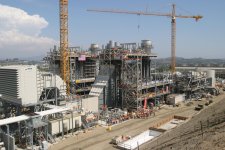A long but worthwile read. Mabey new jobs on the pipelines.
By Robert Campbell Robert Campbell – Wed Mar 9, 1:41 pm ET
MEXICO CITY (Reuters) – Americans worried about the pain of $100 U.S. oil should worry a lot more.
Although $100 oil is the headline in U.S. newspapers, most refineries that supply fuel to service stations are paying the equivalent of a much higher price -- and those costs are already being felt when consumers fill up their vehicles.
The cause is an unprecedented disconnect between the most visible price of oil -- crude oil futures contracts on the New York Mercantile Exchange (NYMEX) -- and the real cost of physical barrels pumped from the Gulf of Mexico, Saudi Arabia and elsewhere.
This gap is caused by oil traders' growing realization that inventories at the small Oklahoma town of Cushing -- the delivery point for the NYMEX contract -- will likely be awash with crude for months to come due to booming production from Canada and shale oil producing states such as North Dakota.
Because the U.S. pipeline system was designed to import oil from the coast to the interior, not vice versa, there's no way to move the extra northern crude to the southern refiners, in places such as Houston and Port Arthur, Texas, which are paying much higher rates for crude from far abroad.
Refiners on the West, Gulf and East coasts -- who produce or import nearly 85 percent of America's fuel -- are therefore forced to pay a premium of $15 to $20 relative to the current futures price of $100 a barrel to keep their plants fed, and pump prices are reflecting that premium.
U.S. oil futures, also called West Texas Intermediate (WTI) after a kind of oil produced in Texas, are no longer the reliable yardstick for the world price and a clear signal of demand for high quality oil from the world's biggest consumer that they once were. They have instead become more of an indicator of the degree of oversupply in the heart of the North American continent.
The most visible evidence of this disparity can be seen in the price of ICE Brent crude futures, the European benchmark; it has risen 21 percent this year, while WTI futures have gained only 15 percent. Normally trading at parity to WTI, Brent surged last week to a record premium of $17.
Although that spread has contracted sharply over the past few days, trading on Wednesday at about $10, the correction has brought its own set of problems. On Monday, for example, the two contracts moved sharply in opposite directions, sowing confusion about whether oil costs had gone up or down.
The result is that WTI, the light sweet crude that Americans have long associated with "the" price of oil, has become a dangerously inaccurate indicator.
And that has major implications for consumers and companies given that at $100 a barrel many economists see limited risk to the U.S. economy but at $120 serious headwinds become evident.
"The hike to something which is between $110 and $120 a barrel is something which may affect (growth) if it lasts too long," said International Monetary Fund chief Dominique Strauss-Kahn, during a visit to Panama last week.
It was, though, unclear whether he was talking Brent or WTI.
WHY IS WTI DISCONNECTED FROM OTHER MARKETS?
The massive gap in prices is caused by a major shift in the way the United States imports crude. There's simply too much oil landlocked in the middle of the country -- not a bad thing for a nation eager for more supply security.
While still dependent upon imports to meet more than half its oil consumption, the U.S. market is struggling to absorb the fast-growing share arriving by pipeline instead of by sea.
In addition to the well-documented boom in Canadian oil sands output, domestic production is also finally growing anew -- not in the traditional oil patches of Texas and the Gulf of Mexico, but from North Dakota shale formations that were once written off as too costly to tap.
Instead of flowing all the way to the Gulf or East Coast, where it is needed most, that new oil is increasingly piling up in Cushing, Oklahoma, a small town of less than 10,000 famous for little apart from being America's pipeline crossroads.
That means that despite the tantalizing prospect of cut-price crude, most U.S. refineries cannot buy WTI or other Midwestern crudes -- there aren't enough railcars, road tankers or barges to get around the bottleneck today, and a permanent solution depends on building new high-capacity pipelines.
Instead on the coasts, refiners are paying the going international price of oil -- even if that means paying $10 more for types of oil, such as Brent, that are almost identical in quality to the WTI equivalents that are filling storage tanks in Cushing.
"They are both light sweet crudes and both yield lots of gasoline and diesel. If you were to take it strictly from the (refined product) yield, the price difference would be a dollar or $1.50 tops," said Peter Beutel, president of Cameron Hanover, a firm in New Canaan, Connecticut, that provides energy hedging advice.
WHY ARE US GASOLINE PRICES HIGH?
The same logistical and benchmark issues don't affect gasoline, however, and prices have risen more swiftly as one glance at the pump can tell you.
When U.S. West Texas Intermediate crude oil futures broke $100 a barrel in February 2008, the national average retail price rose to $3.18 per gallon by the end of the month.
Three years later WTI futures are again just above $100 a barrel but retail prices are now topping $3.50 a gallon.
Indeed, gasoline prices in the United States posted their second-biggest increase ever in a two-week period, according to the Lundberg Survey of about 2,500 gas stations released on Sunday.
The benchmark NYMEX gasoline price is set in New York Harbor, linking it more closely with the globally traded market than WTI crude, which is set in Cushing.
The few refiners that have access to the cheaper crude oil in the U.S. Midwest are under no obligation to pass on those savings to customers. Instead they are reaping windfall profits because the market price for gasoline and diesel is being set by the more costly crude most refiners have to use.
Gasoline in New York or Houston isn't much cheaper than it is in Illinois and other parts of the Midwest as it is much more easily transportable than crude.
For consumers, there may be worse to come even if crude oil prices start to stabilize. There's often a lag time of weeks or months before oil contracts reach the global spot market price.
By Robert Campbell Robert Campbell – Wed Mar 9, 1:41 pm ET
MEXICO CITY (Reuters) – Americans worried about the pain of $100 U.S. oil should worry a lot more.
Although $100 oil is the headline in U.S. newspapers, most refineries that supply fuel to service stations are paying the equivalent of a much higher price -- and those costs are already being felt when consumers fill up their vehicles.
The cause is an unprecedented disconnect between the most visible price of oil -- crude oil futures contracts on the New York Mercantile Exchange (NYMEX) -- and the real cost of physical barrels pumped from the Gulf of Mexico, Saudi Arabia and elsewhere.
This gap is caused by oil traders' growing realization that inventories at the small Oklahoma town of Cushing -- the delivery point for the NYMEX contract -- will likely be awash with crude for months to come due to booming production from Canada and shale oil producing states such as North Dakota.
Because the U.S. pipeline system was designed to import oil from the coast to the interior, not vice versa, there's no way to move the extra northern crude to the southern refiners, in places such as Houston and Port Arthur, Texas, which are paying much higher rates for crude from far abroad.
Refiners on the West, Gulf and East coasts -- who produce or import nearly 85 percent of America's fuel -- are therefore forced to pay a premium of $15 to $20 relative to the current futures price of $100 a barrel to keep their plants fed, and pump prices are reflecting that premium.
U.S. oil futures, also called West Texas Intermediate (WTI) after a kind of oil produced in Texas, are no longer the reliable yardstick for the world price and a clear signal of demand for high quality oil from the world's biggest consumer that they once were. They have instead become more of an indicator of the degree of oversupply in the heart of the North American continent.
The most visible evidence of this disparity can be seen in the price of ICE Brent crude futures, the European benchmark; it has risen 21 percent this year, while WTI futures have gained only 15 percent. Normally trading at parity to WTI, Brent surged last week to a record premium of $17.
Although that spread has contracted sharply over the past few days, trading on Wednesday at about $10, the correction has brought its own set of problems. On Monday, for example, the two contracts moved sharply in opposite directions, sowing confusion about whether oil costs had gone up or down.
The result is that WTI, the light sweet crude that Americans have long associated with "the" price of oil, has become a dangerously inaccurate indicator.
And that has major implications for consumers and companies given that at $100 a barrel many economists see limited risk to the U.S. economy but at $120 serious headwinds become evident.
"The hike to something which is between $110 and $120 a barrel is something which may affect (growth) if it lasts too long," said International Monetary Fund chief Dominique Strauss-Kahn, during a visit to Panama last week.
It was, though, unclear whether he was talking Brent or WTI.
WHY IS WTI DISCONNECTED FROM OTHER MARKETS?
The massive gap in prices is caused by a major shift in the way the United States imports crude. There's simply too much oil landlocked in the middle of the country -- not a bad thing for a nation eager for more supply security.
While still dependent upon imports to meet more than half its oil consumption, the U.S. market is struggling to absorb the fast-growing share arriving by pipeline instead of by sea.
In addition to the well-documented boom in Canadian oil sands output, domestic production is also finally growing anew -- not in the traditional oil patches of Texas and the Gulf of Mexico, but from North Dakota shale formations that were once written off as too costly to tap.
Instead of flowing all the way to the Gulf or East Coast, where it is needed most, that new oil is increasingly piling up in Cushing, Oklahoma, a small town of less than 10,000 famous for little apart from being America's pipeline crossroads.
That means that despite the tantalizing prospect of cut-price crude, most U.S. refineries cannot buy WTI or other Midwestern crudes -- there aren't enough railcars, road tankers or barges to get around the bottleneck today, and a permanent solution depends on building new high-capacity pipelines.
Instead on the coasts, refiners are paying the going international price of oil -- even if that means paying $10 more for types of oil, such as Brent, that are almost identical in quality to the WTI equivalents that are filling storage tanks in Cushing.
"They are both light sweet crudes and both yield lots of gasoline and diesel. If you were to take it strictly from the (refined product) yield, the price difference would be a dollar or $1.50 tops," said Peter Beutel, president of Cameron Hanover, a firm in New Canaan, Connecticut, that provides energy hedging advice.
WHY ARE US GASOLINE PRICES HIGH?
The same logistical and benchmark issues don't affect gasoline, however, and prices have risen more swiftly as one glance at the pump can tell you.
When U.S. West Texas Intermediate crude oil futures broke $100 a barrel in February 2008, the national average retail price rose to $3.18 per gallon by the end of the month.
Three years later WTI futures are again just above $100 a barrel but retail prices are now topping $3.50 a gallon.
Indeed, gasoline prices in the United States posted their second-biggest increase ever in a two-week period, according to the Lundberg Survey of about 2,500 gas stations released on Sunday.
The benchmark NYMEX gasoline price is set in New York Harbor, linking it more closely with the globally traded market than WTI crude, which is set in Cushing.
The few refiners that have access to the cheaper crude oil in the U.S. Midwest are under no obligation to pass on those savings to customers. Instead they are reaping windfall profits because the market price for gasoline and diesel is being set by the more costly crude most refiners have to use.
Gasoline in New York or Houston isn't much cheaper than it is in Illinois and other parts of the Midwest as it is much more easily transportable than crude.
For consumers, there may be worse to come even if crude oil prices start to stabilize. There's often a lag time of weeks or months before oil contracts reach the global spot market price.


/cloudfront-us-east-2.images.arcpublishing.com/reuters/V2WLSQJ3ENKOFKJDIPAINNWKQU.jpg)










